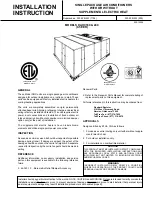
En-3
2. ABOUT THIS PRODUCT
2. 1. Precautions for using R410A refrigerant
Pay careful attention to the following points:
Since the working pressure is 1.6 times higher than that of R22 models, some of the pip-
ing and installation and service tools are special. (See the table in the SPECIAL TOOLS
FOR R410A section.)
Especially, when replacing a conventional refrigerant (other than R410A) model with a
new refrigerant R410A model, always replace the conventional piping and
fl
are nuts with
the R410A piping and
fl
are nuts.
Models that use refrigerant R410A have a different charging port thread diameter to pre-
vent erroneous charging with R22, R407C and for safety. Therefore, check beforehand.
[The charging port thread diameter for R410A is 1/2 UNF 20 threads per inch.]
Be more careful than the installation of the refrigerant (other than R410A) models, not
to enter foreign matters (oil, water, etc.) and other refrigerant into the piping. Also, when
storing the piping, securely seal the openings by pinching, taping, etc.
When charging the refrigerant, take into account the slight change in the composition of
the gas and liquid phases, and always charge from the liquid phase side whose compo-
sition is stable.
2. 2. Special tools for R410A
Tool name
Contents of change for R22 tool
Gauge mani-
fold
Pressure is huge and cannot be measured with a conventional gauge. To
prevent erroneous mixing of other refrigerants, the diameter of each port
has been changed.
It is recommended to use a gauge manifold with a high pressure display
range -0.1 to 5.3 MPa and a low pressure display range -0.1 to 3.8 MPa.
Charging
hose
To increase pressure resistance, the hose material and base size were
changed.
Vacuum
pump
A conventional vacuum pump can be used by installing a vacuum pump
adapter.
• A conventional vacuum pump can be used by installing a vacuum
pump adapter.
• Be sure that the pump oil does not back
fl
ow into the system. Use one
capable for vacuum suction of -100.7kPa (5 Ton, -755mmHg).
Gas leakage
detector
Special gas leakage detector for HFC refrigerant R410A.
2. 3. Accessories
Use connecting parts as required.
Do not throw away the connecting parts until the installation has been complete.
Name and shape
Q’ty
Application
Speci
fi
cations
manual
1
—
Installation
manual
1
(This book)
Drain cap
3
For outdoor unit drain piping work
Drain pipe
1
For outdoor unit drain piping work
Cable tie
4
For binding power cable and
transmission cable
Reducer
1
For connecting gas pipe
(For 60 model)
Conduit plate
1
To
fi
x Conduit tube
2. 4. Optional parts
CAUTION
The following parts are optional parts speci
fi
c to R410A refrigerant.
Do not use parts other than those listed below.
2. 4. 1. Separation tube kit
Separation tube uses the following parts.
Separation tube
Total cooling capacity of indoor unit (kw)
UTP-AX054A
ALL
2. 4. 2. Header
Header uses the following parts. A header is used for connecting the indoor units.
Header
Total cooling capacity of
indoor unit (kw)
3-6 Branches
3-8 Branches
UTR-H0906L
UTR-H0908L
ALL
2. 4. 3. External connect kit
Model
Usage
UTY-XWZXZ6
For External input (CN131, CN132, CN133, CN134)
For External output (Error status / CN136) (Operation status / CN137)
UTY-XWZXZF
For External input (CN135)
UTY-XWZXZ9
For External output (Base heater / CN115)
3. INSTALLATION WORK
Please obtain the approval of the customer when selecting the location of installation and
installing the main unit.
3. 1. Selecting an installation location
WARNING
Install the unit in a location that can withstand its weight, and where it will not topple or
fall.
Calculate the proper refrigerant concentration if you will be installing it in an enclosed
location.
Total amount of replenished refrigerant
in refrigerant facility [lb. (kg)]
≤
Refrigerant concentration [lb/Mcf (kg/m³)]
[25 lb/Mcf (0.39 kg/m³)]
Capacity of smallest room where unit
is installed [Mcf (m³)]
If the results of the calculation exceed the concentration limit, increase the room surface
area or install a ventilation duct.
CAUTION
Please install the outdoor unit without slant. (within 3 degrees)
Install this unit in a location with good ventilation.
If the unit must be installed in an area within easy reach of the general public, install as
necessary a protective fence or the like to prevent their access.
Install the unit in an area that would not inconvenience your neighbors, as they could be
affected by the air
fl
ow coming out from the outlet, noise, or vibration.
If it must be installed in proximity to your neighbors, be sure to obtain their approval.
If the unit is installed in a cold region that is affected by snow accumulation, snow fall, or
freezing, take appropriate measures to protect it from those elements.
To ensure a stable operation, install inlet and outlet ducts.
Install the unit in an area that would not cause problems even if the drain water is
discharged from the unit. Otherwise, provide drainage that would not affect people or
objects.
Install the unit in an area that has no heat sources, vapors, or the risk of the leakage of
fl
ammable gas in the vicinity.
Install the unit in an area that is away from the exhaust or vent ports that discharge
vapor, soot, dust, or debris.
Install the indoor unit, outdoor unit, power supply cable, transmission cable and remote
control cable at least 40 in (1 m) away from a television or radio.
The purpose of this is to prevent TV reception interference or radio noise. (Even if they
are installed more than 40 in (1 m) apart, you could still receive noise under some signal
conditions.)
Keep the length of the piping of the indoor and outdoor units within the allowable range.
For maintenance purposes, do not bury the piping.
9380545095_IM.indb 3
9380545095_IM.indb 3
11/17/2015 4:14:25 PM
11/17/2015 4:14:25 PM






































